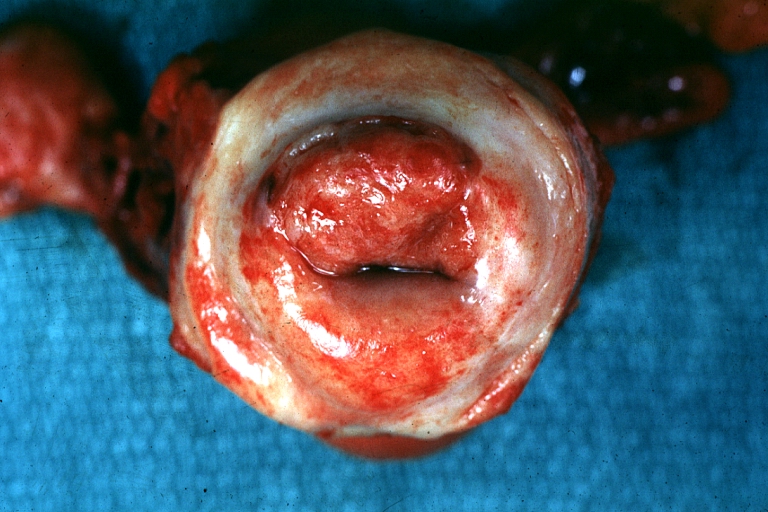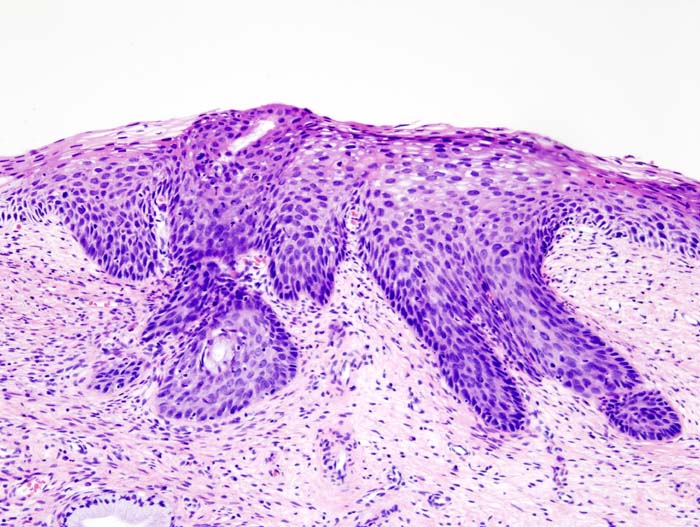Cervical cancer screening: Difference between revisions
No edit summary |
mNo edit summary |
||
| Line 1: | Line 1: | ||
{{Cervical cancer}} | {{Cervical cancer}} | ||
{{CMG}} | {{CMG}} | ||
==Overview== | |||
==Biopsy procedures== | ==Biopsy procedures== | ||
| Line 7: | Line 9: | ||
Further diagnostic procedures are [[loop electrical excision procedure]] (LEEP) and [[conization]], in which the inner lining of the cervix is removed to be examined pathologically. These are carried out if the biopsy confirms severe [[cervical intraepithelial neoplasia]]. | Further diagnostic procedures are [[loop electrical excision procedure]] (LEEP) and [[conization]], in which the inner lining of the cervix is removed to be examined pathologically. These are carried out if the biopsy confirms severe [[cervical intraepithelial neoplasia]]. | ||
==Pathologic types== | |||
[[Cervical intraepithelial neoplasia]], the precursor to cervical cancer, is often diagnosed on examiniation of cervical biopsies by a [[pathology|pathologist]]. | [[Cervical intraepithelial neoplasia]], the precursor to cervical cancer, is often diagnosed on examiniation of cervical biopsies by a [[pathology|pathologist]]. | ||
[[Histopathology|Histologic]] subtypes of invasive cervical carcinoma include the following: | [[Histopathology|Histologic]] subtypes of invasive cervical carcinoma include the following: | ||
Revision as of 20:35, 13 January 2012
|
Cervical cancer Microchapters |
|
Diagnosis |
|---|
|
Treatment |
|
Case Studies |
|
Cervical cancer screening On the Web |
|
American Roentgen Ray Society Images of Cervical cancer screening |
|
Risk calculators and risk factors for Cervical cancer screening |
Editor-In-Chief: C. Michael Gibson, M.S., M.D. [1]
Overview
Biopsy procedures
While the pap smear is an effective screening test, confirmation of the diagnosis of cervical cancer or pre-cancer requires a biopsy of the cervix. This is often done through colposcopy, a magnified visual inspection of the cervix aided by using an acetic acid (e.g. vinegar) solution to highlight abnormal cells on the surface of the cervix.
Further diagnostic procedures are loop electrical excision procedure (LEEP) and conization, in which the inner lining of the cervix is removed to be examined pathologically. These are carried out if the biopsy confirms severe cervical intraepithelial neoplasia.
Pathologic types
Cervical intraepithelial neoplasia, the precursor to cervical cancer, is often diagnosed on examiniation of cervical biopsies by a pathologist. Histologic subtypes of invasive cervical carcinoma include the following:
- squamous cell carcinoma (about 80-85%)
- adenocarcinoma
- adenosquamous carcinoma
- small cell carcinoma
- neuroendocrine carcinoma
Non-carcinoma malignancies which can rarely occur in the cervix include
Pathological Findings
-
Uterus: Cervical Carcinoma: Gross, an excellent example of tumor (labeled as invasive)
Image courtesy of Professor Peter Anderson DVM PhD and published with permission © PEIR, University of Alabama at Birmingham, Department of Pathology -
Histopathologic image (H&E stain) of cervical intraepithelial neoplasia.

